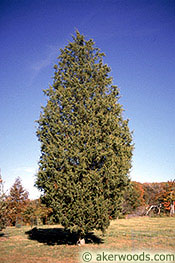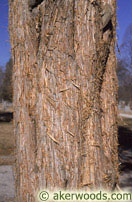Aker Woods: Tree Species (Eastern Redcedar)
 (Photo Caption) Eastern Redcedar trees have very dense branches. They're great at providing protection for wildlife, and yield very knotty lumber.
(Photo Caption) Eastern Redcedar trees have very dense branches. They're great at providing protection for wildlife, and yield very knotty lumber.
The most common name for our Cedar is Eastern Redcedar, but this species is actually a type of Juniper. It's distinct from Western Red Cedar, which is a true cedar and grows much larger. As a member of the Cypress Family, it is related to Arborvitae and False Cypress. Compared to Western Red Cedar, Eastern Redcedar is more aromatic, has a richer maroon color, and is much knottier. Eastern Redcedar also has a very strong contrast between the red color of the heartwood and the cream color of the sapwood.
Traditional uses of Eastern Redcedar are cedar chests, closet lining, wood shavings, carvings, pencils, fence posts, and railings. We have a source of unusually large Redcedar logs, and we can make them into beautiful flooring, fireplace mantles, and beams.
 (Photo Caption) Eastern Redcedar has a unique, peeling bark with deep seams of bark intruding into the wood on the bottom part of the tree. These seams are called flutes. (Photo Caption) Eastern Redcedar has a unique, peeling bark with deep seams of bark intruding into the wood on the bottom part of the tree. These seams are called flutes.
Eastern Redcedar is naturally rot and insect resistant. Posts set over 100 years ago are still supporting local barb-wire fences, without the use of any wood preservatives. Because this is a small tree, it yields limited sizes of logs and lumber. The largest logs are about 8" diameter at 16' in height. The largest lumber is about 8"x8" x 10' in length and 4"x4" x 20' in length.
|